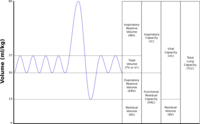
Photo from wikipedia
OBJECTIVES Prognostic challenges hinder the identification of patients with advanced chronic obstructive pulmonary disease (COPD) for timely palliative interventions. We postulate that a two-minute derivative (two-minute walking distance [2MWD]) of… Click to show full abstract
OBJECTIVES Prognostic challenges hinder the identification of patients with advanced chronic obstructive pulmonary disease (COPD) for timely palliative interventions. We postulate that a two-minute derivative (two-minute walking distance [2MWD]) of a standard six-minute walk test (6MWT) can identify frail subjects with poorer survival for early palliative intervention. The primary outcome of interest is mortality at 18 months. Secondary objectives include evaluation of the relationship between the 2MWD and ability to self-care, dyspnea-related disabilities, nutrition, forced expiratory volume in first second (FEV1), quality of life (QoL), and comorbidity burden. DESIGN AND SETTING One hundred twenty-four subjects with stage 3 and 4 COPD were recruited and followed up. Ability to self-care, dyspnea-related disabilities, airflow limitation, nutrition, and QoL were measured by using modified Barthel index (MBI), Modified Medical Research Council (MMRC) dyspnea scale, FEV1 (% predicted), BODE [BMI(B), FEV1(O), MMRC(D), 6MWT(E)] index, updated ADO [Age(A), MMRC(D), FEV1(O)] index, Subjective Global Assessment (SGA), and St. George's Respiratory Questionnaire (SGRQ), respectively. Survival data were prospectively collected and analyzed. RESULTS The 2MWD correlates highly with BODE and predicts updated ADO independent of age, co-morbidities, long-term oxygen therapy (LTOT), body mass index, and FEV1. Log-rank test performed with Kaplan-Meier plots demonstrates that 2MWD ≤80 m significantly predicts survival time (p < 0.05). Cox proportional hazard regression shows a 3.6-time greater probability of 18-month mortality (hazard ratio [HR] 3.57; 95% confidence interval [CI] 1.26-10.13; p < 0.05). In addition, 2MWD strongly predicted MBI and MMRC, independent of age, co-morbidities, LTOT, body mass index, and FEV1. Subjects with 2MWD ≤80 m have a poorer ability to self-care (median MBI 90 vs. 100), lower FEV1 (32.9% ± 9.8% vs. 38.1% ± 9.4%), poorer QoL (mean SGRQ 46.6 ± 16.2 vs. 36.6 ± 13.3), and greater dyspnea-related disability (mean MMRC 1.7 ± 0.7 vs. 0.9 ± 0.6), and they are more malnourished (40.4% vs. 9.7%; RR 1.51) (all p < 0.001). CONCLUSION 2MWD ≤80 m identifies subjects with higher mortality, greater functional dependence, poorer in nutrition, greater dyspnea, and lower QoL. Incorporation of 2MWD into composite prognostic indices can enhance predictive accuracy and identify patients requiring early proactive palliative interventions.
Journal Title: Journal of palliative medicine
Year Published: 2017
Link to full text (if available)
Share on Social Media: Sign Up to like & get
recommendations!